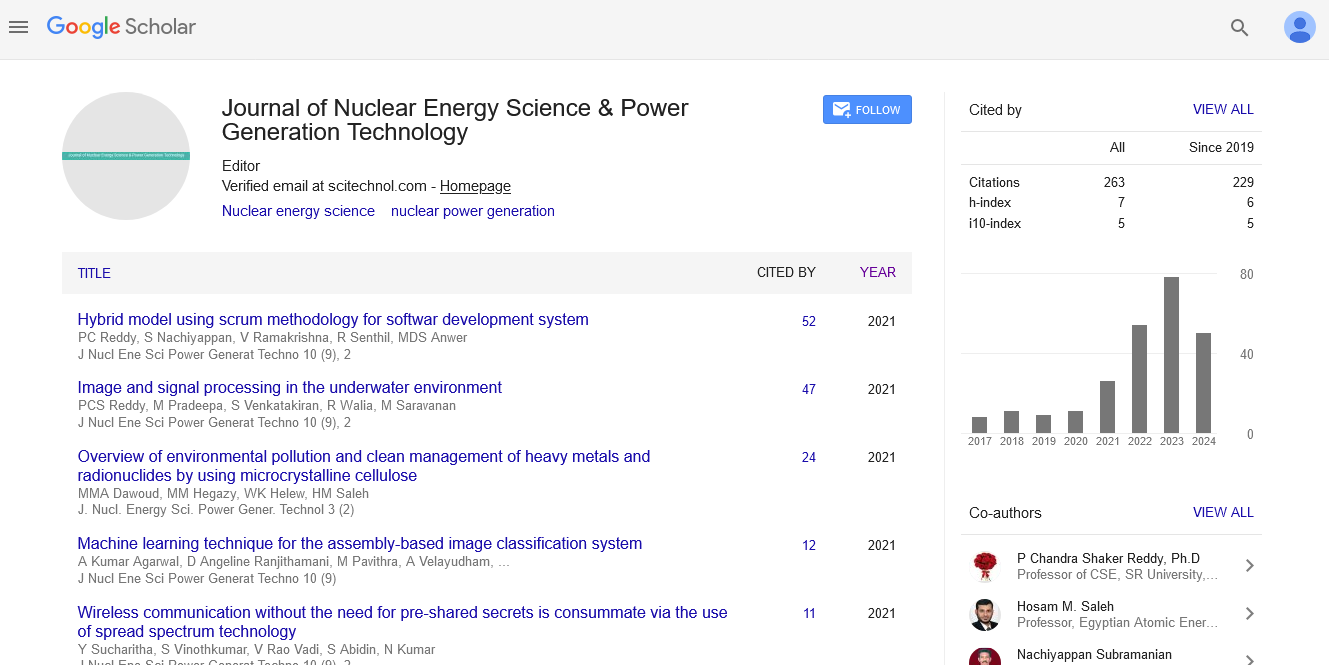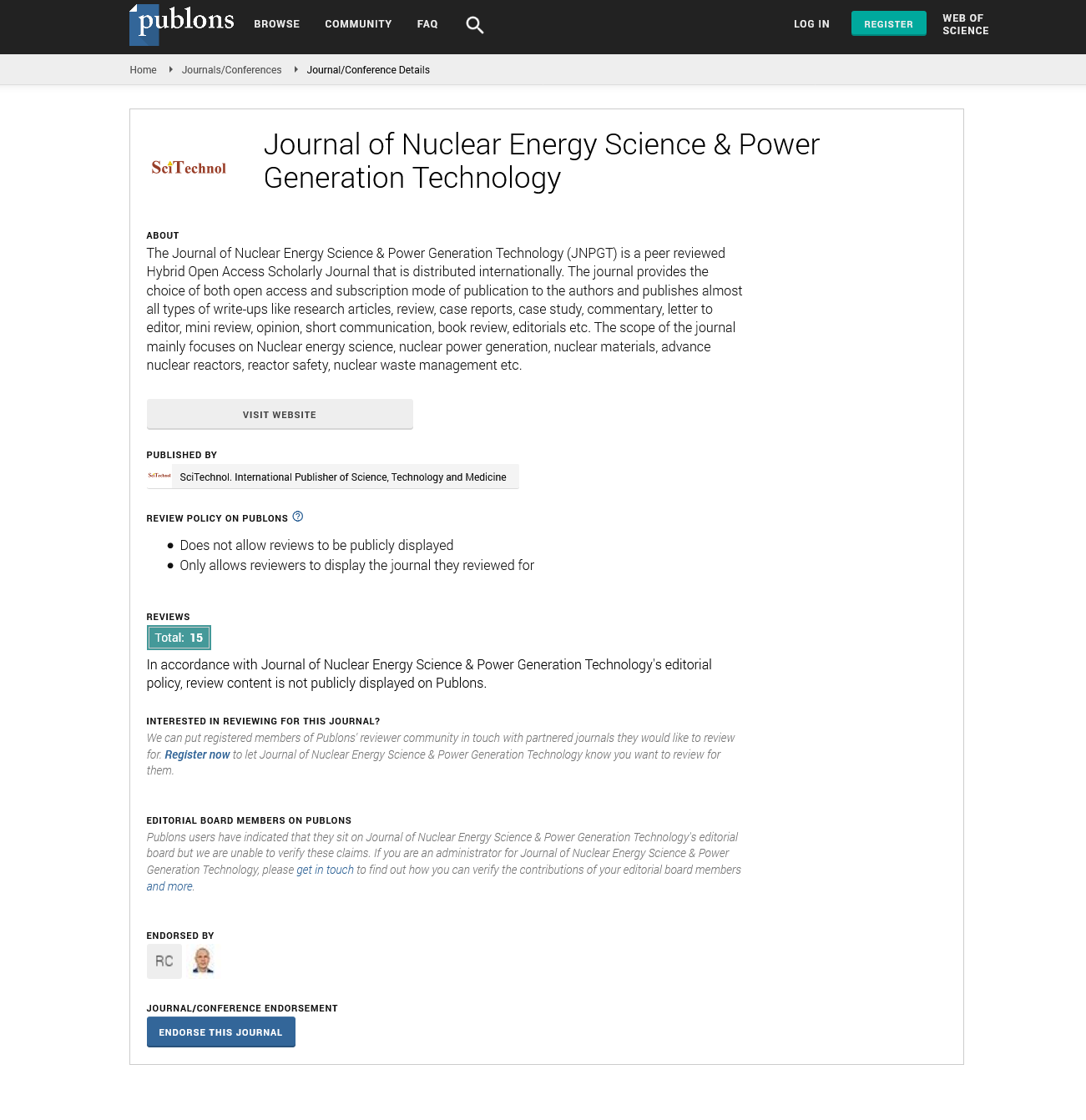Perspective, J Nucl Ene Sci Power Generat Technol Vol: 13 Issue: 4
Laser Enrichment: Advancements and Applications in Uranium Processing
Kyun Sieo*
1Department of Nuclear and Quantum Engineering, Korea Advanced Institute of Science and Technology, Daejeon, South Korea
*Corresponding Author: Kyun Sieo,
Department of Nuclear and Quantum
Engineering, Korea Advanced Institute of Science and Technology, Daejeon, South
Korea
E-mail: kyun_sieo23@gmail.com
Received date: 17 June, 2024, Manuscript No. JNPGT-24-143360;
Editor assigned date: 19 June, 2024, PreQC No. JNPGT-24-143360 (PQ);
Reviewed date: 03 July, 2024, QC No. JNPGT-24-143360;
Revised date: 11 July, 2024, Manuscript No. JNPGT-24-143360 (R);
Published date: 18 July, 2024, DOI: 10.4172/2325-9809.1000410.
Citation: Sieo K (2024) Laser Enrichment: Advancements and Applications in Uranium Processing. J Nucl Ene Sci Power Generat Technol 13:4.
Description
Laser enrichment is a refined technology used to increase the concentration of uranium-235 (U-235) isotope in uranium, which is important for nuclear fuel and weapons. This method, which relies on laser technology, represents a significant advancement over traditional enrichment processes like gaseous diffusion and centrifugation. By providing improved efficiency and selectivity, laser enrichment has the potential to revolutionize the nuclear fuel cycle and enhance the sustainability of nuclear energy. Uranium, found in nature, is primarily composed of two isotopes: Uranium-238 (U-238) and uranium-235 (U-235). The latter is fissile, meaning it can sustain a nuclear chain reaction, making it essential for nuclear reactors and weapons. However, U-235 constitutes only about 0.7% of natural uranium, while U-238 makes up the remaining 99.3%. To be useful in nuclear reactors or for weapons, uranium must be enriched to increase the concentration of U-235. Laser enrichment provides a means to achieve this with high precision and efficiency.
The principle behind laser enrichment involves selectively ionizing or exciting the U-235 isotope using laser light. There are several laserbased techniques for uranium enrichment, each with its own unique approach and advantages. The most prominent methods are Atomic Vapor Laser Isotope Separation (AVLIS) and Molecular Laser Isotope Separation (MLIS). AVLIS works by vaporizing uranium metal and exposing the vapor to a laser beam tuned to the specific wavelength that ionizes U-235 atoms. This ionization process creates positively charged U-235 ions, which are then separated from the un-ionized U-238 atoms using an electric or magnetic field. The U-235 ions are collected, and the remaining U-238 is discarded. AVLIS provides high separation efficiency and can achieve the desired enrichment levels with relatively low energy consumption. MLIS, on the other hand, involves the use of lasers to excite Uranium Hexafluoride (UF6) gas, which is a common form of uranium used in enrichment processes. In this method, a laser beam targets specific vibrational or electronic transitions of the UF6 molecules containing U-235, causing them to become selectively excited. This excitation results in a separation of the enriched U-235 from the U-238, which is then collected. MLIS is advantageous for its potential to achieve high purity levels and lower operational costs.
Both AVLIS and MLIS provide significant benefits over traditional enrichment methods. The primary advantage of laser enrichment lies in its efficiency. Traditional methods like gaseous diffusion and centrifugation require large amounts of energy and extensive infrastructure. In contrast, laser enrichment can achieve higher separation factors with less energy input, making it a more costeffective and environmentally approachable option. Moreover, laser enrichment provides greater precision in isotope separation. The ability to target specific isotopes with high accuracy reduces the amount of material processed and minimizes waste. This precision also allows for the production of uranium with specific isotopic compositions tailored for different reactor types or applications, enhancing the versatility of nuclear fuel production.
However, laser enrichment is not without challenges. One of the main concerns is the potential for proliferation. The technology's capability to produce highly enriched uranium makes it a subject of interest for non-proliferation efforts. Ensuring that laser enrichment technology is used responsibly and monitored effectively is important to prevent its misuse for nuclear weapons development. Additionally, the high cost of developing and deploying laser enrichment facilities can be a barrier to widespread adoption. Research and development in this field require significant investment, and the technology must be scaled up to become commercially viable.
Conclusion
In conclusion, laser enrichment represents a significant technological advancement in the field of uranium processing. By providing improved efficiency, precision, and potential cost savings, laser enrichment has the potential to revolutionize the nuclear fuel cycle. While challenges remain, ongoing research and development helpful for its broader adoption and application. As the world seeks to transition to more sustainable energy sources, laser enrichment stands as a key player in the future of nuclear energy. Despite these challenges, the future of laser enrichment holds potential. Ongoing advancements in laser technology, materials science, and process optimization continue to improve the efficiency and cost-effectiveness of laser-based enrichment methods. As the global demand for clean and sustainable energy increases, laser enrichment could play an essential role in meeting this demand by providing a more efficient and environmentally approachable means of producing nuclear fuel.
 Spanish
Spanish  Chinese
Chinese  Russian
Russian  German
German  French
French  Japanese
Japanese  Portuguese
Portuguese  Hindi
Hindi 

